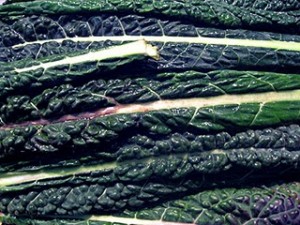Have you ever experienced a burning sensation in your throat after eating kale? You’re not alone.
This surprising reaction can leave many puzzled and uncomfortable. Kale is often hailed as a superfood, packed with nutrients and health benefits. But for some, it can cause an unpleasant burning sensation in the throat. Understanding why this happens is important for those who want to enjoy the benefits of kale without the discomfort.
In this blog post, we’ll explore the reasons behind this reaction and provide tips to prevent it. Whether you’re a kale lover or simply curious, read on to uncover the mystery behind why kale burns your throat.

Credit: www.youtube.com
Common Reactions To Kale
Kale is a popular leafy green vegetable, known for its health benefits. But, some people experience throat irritation after eating it. This reaction can be uncomfortable and worrying. In this section, we will explore the common reactions to kale.
Causes Of Throat Irritation
Several factors can cause throat irritation from kale. Here are the main causes:
- Oxalates: Kale contains oxalates, which can cause irritation in some people.
- Fibrous Texture: The tough fibers in kale can be hard to swallow, causing discomfort.
- Allergic Reactions: Some individuals may be allergic to kale, leading to throat irritation.
Symptoms To Watch For
If you experience throat irritation after eating kale, watch for these symptoms:
- Itchy or scratchy throat
- Swelling in the throat
- Difficulty swallowing
- Redness or inflammation
These symptoms can vary in severity. If you notice any of these signs, consider reducing your kale intake or consulting a doctor.

Credit: www.mrbeer.com
Why Kale Can Be Irritating
Kale is hailed as a superfood with numerous health benefits. But for some, it can cause throat irritation. This irritation can be uncomfortable and even painful. Let’s explore the reasons why kale might be causing this issue.
Oxalates In Kale
Oxalates are natural compounds found in many plants, including kale. They can bind with calcium to form crystals. These crystals can irritate the throat and other tissues. Here’s a closer look at how oxalates can affect you:
- High Oxalate Content: Kale contains high levels of oxalates.
- Crystal Formation: Oxalates can form sharp crystals in the throat.
- Possible Symptoms: Irritation, a burning sensation, or discomfort.
For those sensitive to oxalates, even small amounts can cause problems. Cooking kale can reduce oxalate levels. Blanching or steaming are good options. Consider consuming kale in moderation to avoid irritation.
Goitrogens And Throat Sensitivity
Goitrogens are another factor in kale that can cause throat issues. These substances can affect thyroid function and may lead to throat sensitivity. Here’s what you need to know about goitrogens:
- Presence in Kale: Kale contains goitrogens, which can affect the thyroid.
- Thyroid Impact: Goitrogens can interfere with thyroid hormone production.
- Throat Sensitivity: This interference can lead to throat discomfort.
Cooking kale can help reduce goitrogen levels. It’s a simple step to make kale easier on your throat. Eating varied greens can also help manage goitrogen intake.
| Nutrient | Effect | Solution |
|---|---|---|
| Oxalates | Forms crystals causing irritation | Cook kale to reduce oxalates |
| Goitrogens | Interferes with thyroid function | Cook kale to reduce goitrogens |
Preparation Methods
Many people experience a burning sensation in their throat after eating kale. This discomfort can be due to various factors, including the preparation method. Understanding the best way to prepare kale can help reduce this issue.
Cooking Vs. Raw
Cooking kale can significantly reduce the compounds that cause a burning sensation. Heat breaks down the fibers, making it easier to digest. You can steam, sauté, or bake kale.
- Steaming: Steaming kale for 5-10 minutes softens it and reduces bitterness.
- Sautéing: Sautéing with olive oil and garlic enhances flavor and reduces harshness.
- Baking: Baking kale chips at 350°F for 10-15 minutes offers a crispy, mild alternative.
Eating kale raw can be more challenging for those sensitive to its natural compounds. If you prefer raw kale, try massaging the leaves with a bit of olive oil and salt to break down the fibers.
Blending And Juicing
Another way to enjoy kale is by blending or juicing it. Blending kale into smoothies can mask its strong flavor and make it easier to consume. Combine kale with fruits like bananas, apples, or berries for a more palatable drink.
Juicing kale is another option, but it can be intense. Mixing kale juice with other vegetable or fruit juices can help balance the taste and reduce the burning sensation.
- Blending: Blend kale with fruits and a liquid base like almond milk.
- Juicing: Mix kale juice with carrot, apple, or cucumber juice for a milder flavor.
Experimenting with different preparation methods can help you enjoy kale without the discomfort. Consider your preferences and sensitivities to find the best way to include this nutritious vegetable in your diet.

Credit: www.juneauempire.com
Choosing The Right Kale
Picking the right kale can make a huge difference. It affects both taste and health benefits. Understanding the types and quality of kale is essential. This guide will help you make the best choice.
Types Of Kale
There are several varieties of kale. Each type has its unique flavor and texture.
- Curly Kale: This type is the most common. It has ruffled leaves and a peppery flavor.
- Lacinato Kale: Also known as dinosaur kale. It has a darker color and a slightly sweeter taste.
- Red Russian Kale: This variety has flat leaves. It is known for its tender texture and mild flavor.
- Baby Kale: These are young leaves. They are tender and great for salads.
Freshness And Quality
Freshness is key when choosing kale. Look for bright, crisp leaves. Avoid any that are wilted or yellowing.
Quality matters too. Organic kale is often a better choice. It is free from pesticides and chemicals. Local farmers’ markets can be a good source of fresh, high-quality kale.
| Quality Indicator | Description |
|---|---|
| Color | Bright green leaves indicate freshness. |
| Texture | Crisp and firm leaves are best. |
| Smell | Fresh kale should have a mild, earthy scent. |
Remember, fresh and quality kale enhances both taste and health benefits. Choose wisely.
Soothing Remedies
Kale is nutritious but can sometimes cause throat discomfort. Experiencing a burning sensation is not uncommon. Fortunately, there are soothing remedies to ease the discomfort. Let’s explore some effective solutions.
Hydration Tips
Staying hydrated can help alleviate throat irritation. Drinking plenty of water is essential. Here are some hydration tips:
- Drink warm water: Warm water can soothe your throat. It’s gentle and effective.
- Herbal teas: Chamomile or peppermint tea can be calming. They offer relief.
- Avoid caffeine: Caffeinated drinks can dehydrate. Stick to non-caffeinated beverages.
These simple hydration tips can make a significant difference in soothing your throat.
Natural Throat Soothers
Natural remedies can provide relief for a burning throat. Here are a few options:
- Honey: Honey has natural antibacterial properties. It can coat and soothe your throat.
- Ginger: Ginger has anti-inflammatory effects. You can make ginger tea for relief.
- Saltwater gargle: Gargling with salt water can reduce inflammation. It’s an old but effective remedy.
Incorporating these natural soothers into your routine can help ease throat discomfort caused by kale.
Remember, these remedies are easy to follow and can provide quick relief. Try them to soothe your throat and enjoy the health benefits of kale without the burn.
Recipe Adjustments
Does kale burn your throat? Don’t worry, you can adjust recipes to make kale more enjoyable. This section will guide you through some simple adjustments to help you incorporate kale smoothly into your meals and balance the flavors perfectly.
Incorporating Kale Smoothly
To avoid the throat-burning sensation, try using baby kale. Baby kale is softer and less bitter. You can also blend kale with other ingredients to reduce its intensity.
- Blanching: Briefly boil the kale, then cool it in ice water. This makes it softer and milder.
- Massaging: Rub the kale leaves with olive oil and a pinch of salt. This helps break down the tough fibers.
- Mixing: Combine kale with other greens like spinach or arugula. This balances the flavors and textures.
Balancing Flavors
Balancing the flavors can make kale more palatable. Here are some tips to achieve that:
- Acidity: Add a splash of lemon juice or vinegar. The acidity cuts through the bitterness of kale.
- Sweetness: Incorporate sweet ingredients like fruits or honey. This adds a pleasant contrast.
- Spices: Use spices like garlic, ginger, or chili flakes. These spices add depth and mask the bitterness.
Here’s a quick table to summarize the adjustments:
| Adjustment Method | Description |
|---|---|
| Blanching | Boil and cool kale to soften and reduce bitterness. |
| Massaging | Rub with oil and salt to break down fibers. |
| Mixing | Combine with other greens to balance flavors. |
| Acidity | Add lemon juice or vinegar to cut bitterness. |
| Sweetness | Use fruits or honey to add a sweet contrast. |
| Spices | Add garlic, ginger, or chili flakes for depth. |
Alternatives To Kale
If kale burns your throat or you simply want something different, there are many healthy alternatives. Other leafy greens offer similar benefits without the discomfort. Let’s explore some of these options.
Other Leafy Greens
There are many leafy greens that can replace kale in your diet:
- Spinach: A mild and versatile green, great in salads and smoothies.
- Swiss Chard: Colorful and nutrient-rich, perfect for sautéing.
- Collard Greens: Hearty leaves with a slightly bitter taste, ideal for stews.
- Arugula: Peppery and flavorful, adds a punch to salads and sandwiches.
- Romaine Lettuce: Crisp and refreshing, excellent for wraps and salads.
Nutritional Comparisons
How do these alternatives compare nutritionally to kale? Here’s a quick look:
| Leafy Green | Calories per Cup | Vitamin A (% DV) | Vitamin C (% DV) | Calcium (% DV) |
|---|---|---|---|---|
| Kale | 33 | 206% | 134% | 9% |
| Spinach | 7 | 56% | 14% | 3% |
| Swiss Chard | 7 | 44% | 18% | 2% |
| Collard Greens | 11 | 36% | 21% | 5% |
| Arugula | 5 | 47% | 3% | 2% |
| Romaine Lettuce | 8 | 82% | 19% | 2% |
Each of these greens has unique benefits. Choose the one that fits your taste and nutritional needs. Spinach and Swiss chard are low-calorie options. Collard greens and romaine lettuce provide high vitamins A and C. Arugula offers a distinctive flavor for variety in your meals.
Consulting Professionals
Experiencing a burning sensation in your throat after eating kale? It might be time to consult a professional. Sometimes, home remedies and self-care are not enough. Professionals can help identify the root cause and provide tailored advice.
When To See A Doctor
If the burning sensation in your throat persists or worsens, see a doctor. Chronic discomfort might indicate a more serious issue, such as allergies or acid reflux.
- Persistent burning sensation
- Difficulty swallowing
- Unexplained weight loss
These symptoms might require medical attention. Doctors can perform tests to diagnose the problem accurately.
Dietitian Advice
A dietitian can offer valuable advice on how to safely include kale in your diet. They can suggest alternative cooking methods or recipes that might reduce irritation.
| Tip | Benefit |
|---|---|
| Steaming kale | Reduces rough texture |
| Pairing with yogurt | Soothes throat |
Dietitians can also recommend other nutrient-rich greens if kale consistently causes problems. They tailor advice based on individual dietary needs and preferences.
Frequently Asked Questions
Why Does Kale Burn My Throat?
Kale can cause throat irritation due to its high fiber content and natural compounds like isothiocyanates.
How Can I Eat Kale Without Irritation?
Cooking kale can reduce its irritants. Blanching, steaming, or sautéing can make it gentler on your throat.
Is Kale Bad For Sensitive Throats?
Kale can be harsh on sensitive throats. Cooking or blending it in smoothies can help reduce discomfort.
Are There Alternatives To Kale For Sensitive Throats?
Yes, you can try spinach or Swiss chard. These greens are usually less irritating and still nutritious.
Conclusion
Kale burning your throat can be uncomfortable. It’s important to pay attention. Listen to your body and adjust your diet as needed. Cooking kale might help reduce irritation. Consider other greens if the problem persists. Balance is key in every meal.
Always consult a doctor for severe reactions. Exploring alternatives ensures you enjoy nutritious meals. Stay informed and enjoy your healthy journey. Remember, your well-being comes first.




